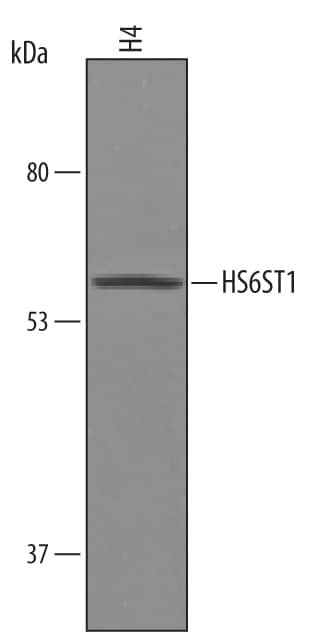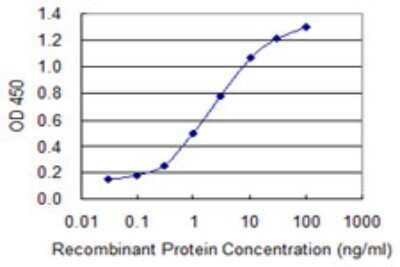Heparan Sulfate 6-O-Sulfotransferase 1/HS6ST1 Products
Heparan Sulfate is a highly sulfated polysaccharide that can be found on cell surface and extracellular matrix. It is usually covalently attached to a protein core as the glycan component of a proteoglycan. Heparan Sulfate interacts with a variety of proteins, such as growth factors, protease inhibitors, cytokines, lipoprotein lipase and viral envelope proteins, thus playing roles from cell growth, cell differentiation, cell motility, blood coagulation, lipid metabolism to viral infection. Heparan Sulfate consists of repeating residues of uronic acid and N-acetylglucosamine. The uronic acid residues can be sulfated at 2-O position by Heparan Sulfate 2-O Sulfotransferase (HS2ST). The N-acetylglucosamine residues can be sulfated at N-, 3-O, and 6-O positions by N-deacetylase/N-sulfotransferases (NDSTs), Heparan Sulfate 3-O and 6-O sulfotransferases (HS3STs and HS6STs) respectively. However, the reactions catalyzed by these sulfotransferases are normally incomplete on the whole chain of Heparan Sulfate. As a result, Heparan Sulfate displays enormous sequence diversity that allows it to interact with a wide spectrum of proteins differently. Among three HS6STs, HS6ST1 is the first to be cloned. Mice deficient of the HS6ST1 homologue gene showed embryonic lethality.
7 results for "Heparan Sulfate 6-O-Sulfotransferase 1/HS6ST1" in Products
7 results for "Heparan Sulfate 6-O-Sulfotransferase 1/HS6ST1" in Products
Heparan Sulfate 6-O-Sulfotransferase 1/HS6ST1 Products
Heparan Sulfate is a highly sulfated polysaccharide that can be found on cell surface and extracellular matrix. It is usually covalently attached to a protein core as the glycan component of a proteoglycan. Heparan Sulfate interacts with a variety of proteins, such as growth factors, protease inhibitors, cytokines, lipoprotein lipase and viral envelope proteins, thus playing roles from cell growth, cell differentiation, cell motility, blood coagulation, lipid metabolism to viral infection. Heparan Sulfate consists of repeating residues of uronic acid and N-acetylglucosamine. The uronic acid residues can be sulfated at 2-O position by Heparan Sulfate 2-O Sulfotransferase (HS2ST). The N-acetylglucosamine residues can be sulfated at N-, 3-O, and 6-O positions by N-deacetylase/N-sulfotransferases (NDSTs), Heparan Sulfate 3-O and 6-O sulfotransferases (HS3STs and HS6STs) respectively. However, the reactions catalyzed by these sulfotransferases are normally incomplete on the whole chain of Heparan Sulfate. As a result, Heparan Sulfate displays enormous sequence diversity that allows it to interact with a wide spectrum of proteins differently. Among three HS6STs, HS6ST1 is the first to be cloned. Mice deficient of the HS6ST1 homologue gene showed embryonic lethality.
| Reactivity: | Human |
| Details: | Sheep IgG Polyclonal |
| Applications: | WB |
| Reactivity: | Human |
| Details: | Mouse IgG2a Monoclonal Clone #584308 |
| Applications: | IHC |
| Reactivity: | Human |
| Details: | Rabbit IgG Polyclonal |
| Applications: | WB, ICC/IF |
| Reactivity: | Human |
| Details: | Mouse IgG2a Kappa Monoclonal Clone #1G4 |
| Applications: | WB, ELISA |
| Applications: | ELISA |
| Applications: | AC |
| Source: | CHO |
| Accession #: | AAY14736 |
| Applications: | EnzAct |



![Western Blot: Heparan Sulfate 6-O-Sulfotransferase 1/HS6ST1 Antibody [NBP1-92010] Western Blot: Heparan Sulfate 6-O-Sulfotransferase 1/HS6ST1 Antibody [NBP1-92010]](https://resources.bio-techne.com/images/products/Heparan-Sulfate-6-O-Sulfotransferase-1-HS6ST1-Antibody-Western-Blot-NBP1-92010-img0004.jpg)

![ELISA: Human Heparan Sulfate 6-O-Sulfotransferase 1/HS6ST1 - Ready-To-Use ELISA Kit (Colorimetric) [NBP3-31902] - Human Heparan Sulfate 6-O-Sulfotransferase 1/HS6ST1 - Ready-To-Use ELISA Kit (Colorimetric)](https://resources.bio-techne.com/images/products/nbp3-31902_heparan-sulfate-6-o-sulfotransferase-1-hs6st1-rtu-elisakit-206202415314838.png)
